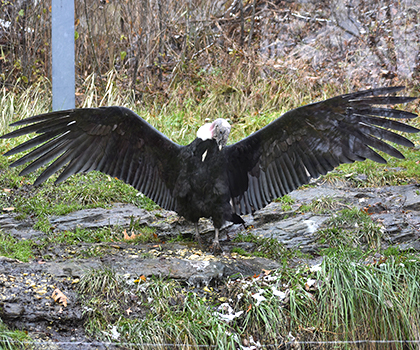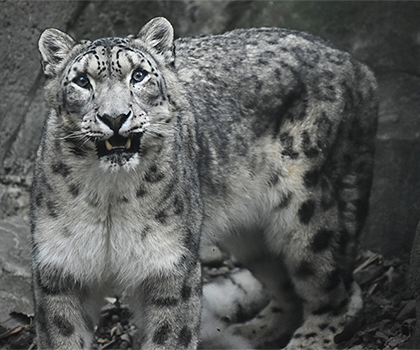Do you recall the stories and legends you heard in your childhood? Some were probably scary. Some were funny. Some may have been true (at least to some degree). But the best legends were the ones that let your imagination fly! This year, World Folk Tales and Fables Week is from March 17 to March 23. At your Akron Zoo, we bring these tales to life in our Legends of the Wild habitat. When you visit, you will notice that our animals are not all from the same geographic area. What ties them together are the legends associated with them, which are used to help ancient cultures understand the animals that we know and love today.
Lemur Howls at the Wind
Fable: Wind was fleeing from Sun when it ran into Lemur. “Help! I played a bad joke on Sun, and now he’s angry with me.” “You can hide in my belly until it’s safe,” offered Lemur. Sun came by and asked if Lemur had seen Wind. When she opened her mouth to answer, Sun could hear Wind. “What was that?” Sun demanded. Lemur closed her mouth and shrugged. When Lemur sees Sun today, she faces him and shrugs her shoulders. If she opens her mouth, Wind booms from her.
Fact: Adult lemurs can make a wide variety of vocalizations to communicate with one another. They also use separate sounds to indicate differences in situation. For example, a lookout would use a different sound to indicate whether a predator is approaching from the ground or from the air.
Condor: Lifts the Sun
 Fable: One day the Sun fell out of the sky. It landed in flames in the foothills of the Andes. “If it sits here, it will burn everything!” the animals cried. Whale tried to take it to the ocean. But it floated, steaming, and she brought it back. Llama carried it to the top of a mountain. But it was too bright. Condor still circles the sky; in case the Sun ever falls again.
Fable: One day the Sun fell out of the sky. It landed in flames in the foothills of the Andes. “If it sits here, it will burn everything!” the animals cried. Whale tried to take it to the ocean. But it floated, steaming, and she brought it back. Llama carried it to the top of a mountain. But it was too bright. Condor still circles the sky; in case the Sun ever falls again.
Fact: Andean condors, like many raptors, take advantage of rising columns of warm air called “thermals” to increase their flight time without increasing the energy needed to fly. Rather than flapping their wings to get lift, raptors glide within the thermal and ride the updraft to higher altitudes.
How Jaguar Got His Spots
Fable: Golden Panther was very vain, loved his Golden fur and cleaned himself constantly. But Golden Panther was hungry. His fur shone in the dark, so he could never sneak up on a meal. One day, as he tried to skirt a puddle, his foot slipped into the mud. “Ugh! My paw is filthy!” he moaned. But the more he tried to clean, the dirtier he got, till he was covered with splotches of mud. Finally, famished, he gave up. As he walked, he spotted a capybara. Capybara didn’t notice him, until it was too late. After that, Jaguar was never called Golden Panther but he never went hungry again.
Fact: A jaguar’s spots are used mainly for camouflage. As shown by the fable, the spots help a jaguar to sneak up on their prey without being noticed.
Bat: Lets Out the Dark
Fable: Bat was asked to carry a basket to Moon but the journey was long, and Bat became tired and hungry. She laid the basket down to get food. Mouse Deer and Mynah saw the basket. Thinking it was food, they opened it but the dark was inside. The darkness flew out of the basket and escaped. Bat returned angry and found the basket empty. Every night she flaps her wings to gather the darkness back up.
Fact: Bats are nocturnal, meaning they are active at night. They are also the only mammal with the ability to fly.
Snow Leopard: Rules the Animals
 Fable: After the world was formed, the animals gathered to decide who would be king. Lion, thinking of his mighty roar, said the king should be the one with a commanding voice. Snow Leopard climbed to the tallest mountain and secretly kicked a rock down the mountainside, sounding like an enormous roar. He was crowned king but cannot leave the mountain top, or his secret will be found out.
Fable: After the world was formed, the animals gathered to decide who would be king. Lion, thinking of his mighty roar, said the king should be the one with a commanding voice. Snow Leopard climbed to the tallest mountain and secretly kicked a rock down the mountainside, sounding like an enormous roar. He was crowned king but cannot leave the mountain top, or his secret will be found out.
Fact: Snow leopards make sounds like those made by other large cats, including a purr, meow, hiss, growl, moan, and yowl. However, snow leopards cannot roar due to the physiology of their throat, and instead make a non-aggressive puffing sounds called a “chuff.”
Come celebrate World Folk Tales and Fables Week and visit all of our legendary animals today. Decide for yourself what is true and what is fable, and maybe you’ll even get some stories of your own for the road!
By Olivia Orolin, Communications Intern. Published March 21, 2019.
